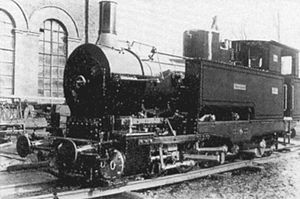Prussian T 36
| Prussian T 36 class 99.462 |
|
|---|---|
|
Prussian T 36
|
|
| Numbering: | Katowice 101-104; 99 4621 |
| Number: | 4th |
| Manufacturer: | Christian Hagans machine factory |
| Year of construction (s): | 1897-1901 |
| Retirement: | 1965 |
| Type : | CB 'n2t, C2' n2t * |
| Genre : | K 55.6, K 35.6 * |
| Gauge : | 785 mm, 750 mm * |
| Length over buffers: | 8,200 mm |
| Height: | 3,000 mm |
| Width: | 1,920 mm |
| Total wheelbase: | 4,650 mm |
| Empty mass: | 23.2 t |
| Service mass: | 27.2 t 266.8 kN |
| Top speed: | 30 km / h |
| Indexed performance : | 158 kW (215 hp) |
| Starting tractive effort: | 42.17 kN |
| Driving wheel diameter: | 810 mm |
| Rear wheel diameter: | 810 mm |
| Control type : | Heusinger |
| Number of cylinders: | 2 |
| Cylinder diameter: | 350 mm |
| Piston stroke: | 400 mm |
| Boiler overpressure: | 12 bar |
| Grate area: | 1.10 m² |
| Radiant heating surface: | 4.41 m² |
| Evaporation heating surface: | 51.60 m² |
| Water supply: | 2.5 m³ |
| Fuel supply: | 1.0 t coal |
| Coupling type: | Balance lever coupling |
| * after reconstruction | |
The vehicles of the Prussian T 36 were steam locomotives of the Upper Silesian Narrow Gauge Railways .
history
The Upper Silesian Narrow Gauge Railway procured four locomotives from the Christian Hagans machine factory in Erfurt between 1897 and 1901 . After the lines were taken over by the Prussian State Railways in 1904, these locomotives were classified as T 36s from 1911 . A locomotive, the Kattowitz 8, from 1911: Kattowitz 105, came via the Rosenberger Kreisbahn with 750 mm gauge (from 1922 as No. 5) and the Stavenhagen sugar factory in 1945 to the Demminer Kreisbahn-West (No. 265). For this purpose, it was converted from 785 millimeters to 750 millimeters gauge in 1922. In 1949 it received the DR number 99 4621. Later it came to Rügen , where it remained until 1965. This locomotive was scrapped there in 1966.
technical features
These vehicles had a special design feature because they were equipped with a rotating drive axle frame. That is why they were also referred to as rocker arm machines . The first three coupling axles were firmly mounted in an inner frame. A Bissel frame with two further driving axles was located under the driver's cab . They were driven by a rocker arm. The locomotives had Heusinger controls . The supplies were housed next to the boiler , a coal box was also behind the driver's cab. After a boiler replacement in the 1950s, locomotive 99 4621 had a steam dome with a frustoconical end. The driver's cab was also renewed and fitted with glass windows and roof vent.
During the re-gauging, the rocker arm drive was removed and the two rear coupling axles were replaced by normal running axles .
literature
- Klaus Kieper, Reiner Preuß: Narrow Gauge Railway Archive. transpress VEB publishing house for transport, Berlin 1980; also under the title: Narrow gauge between the Baltic Sea and the Ore Mountains. Alba Buchverlag, Düsseldorf 1980, ISBN 3-87094-069-7 .
- Horst J. Obermayer: Paperback German narrow-gauge steam locomotives. Franckh, Stuttgart 1971, ISBN 3-440-03818-1 .
- Wolfram Bäumer, Siegfried Bufe: Railways in Pomerania. Bufe-Fachbuchverlag, Egglham 1988, ISBN 3-922138-34-9 .
- Dieter Bäzold, Rolf Löttgers, Günther Scheingraber, Manfred Weisbrod: Prussia Report Volume No. 9. Hermann Merker Verlag, Fürstenfeldbruck 1996, ISBN 3-922404-84-7 .
